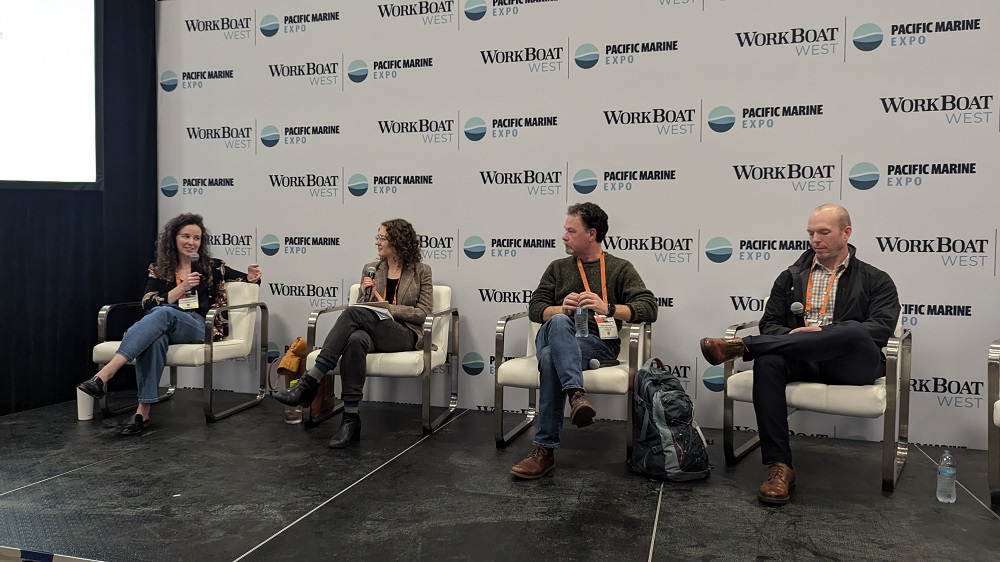The race to eliminate greenhouse gases is top of mind for organizations of all types. Companies like Cummins have outlined comprehensive plans to navigate the challenges and opportunities of achieving net-zero emissions, but what does it mean for others to set similar goals and establish realistic timelines to achieve them?
A WorkBoat West panel at the Pacific Marine Expo highlighted efforts to bridge the gap between suppliers and consumers of sustainable maritime fuels and technologies. Panelists focused on the initiatives and programs that they’re collaborating on in order to expedite the production and utilization of these solutions in Washington and the broader Pacific Northwest region.
Cassidy Fisher is the Director of Joint Innovation at Maritime Blue. She introduced the panel, which included Lauren Hogrewe from the Washington State Department of Commerce, Sean Caughlan from Glosten, and Curt Leffers from Crowley. Each emphasized their organization's role in reducing carbon emissions, noting that the challenge extends beyond fuel sources to encompass the entire logistical chain.
“The fuels most talked about are methanol and ammonia, but in general, any alternative fuel will only decarbonize if that fuel is produced in low-carbon ways,” said Caughlan. “Moving forward, fuels will need to be manufactured rather than just taken out of the ground, and those logistics and costs need to be considered.”
Caughlan mentioned questions associated with how these fuels can be stored, as well as their energy density, as being critical to consider. Ammonia is much less energy-dense than diesel, and methanol still produces carbon. Hydrogen is also talked about being utilized as both a gas and liquid fuel, but energy density and costs are similarly major barriers.
Hogrewe mentioned how the Department of Commerce supports decarbonization efforts through grants and incentives and is specifically committed to the effort. A recent report outlined green electrolytic hydrogen and renewable fuels recommendations for deployment in Washington, which connects with the larger goals of the department.
“We know that the transportation sector is the largest producer of carbon in the state, so there’s a great opportunity in this space,” said Hogrewe. “We’re trying to support policies that make sense for the people using them as well as the communities around them.”
The adoption of new fuels can be a challenge, which is why short-term gains are more of a focus for certain companies.
“One way to think about decarbonization is in two buckets,” said Leffers. “One is low/zero carbon fuels, and the other is efficiency solutions. In the near term, using things like B20 biofuel can help ease a transition. With efficiency solutions, you’re talking about something simple like utilizing more significant hull coatings, and it’s amazing what a thin layer of slime can do to your fuel efficiency.”
Other approaches to ensure optimal speed and fuel consumption have come with on-board artificial intelligence. Leffers also mentioned ducts that can improve energy efficiencies by controlling the water flow to tanker propellers. Adopting any of these fuels or tools ultimately comes down to the incentives, though, and the panel called out the various incentives California has enacted. What new policies could be enabled to get access to renewable diesel?
“The only way we can reach cost parity without incentives is by scaling,” said Caughlan. “I think you need a carrot and a stick. If you mandate change but don’t give people the tools for financing and capital, you’ll create a contentious relationship that doesn’t accelerate anything.”
Renewable diesel was mentioned as a potential bridge fuel to ease the shift from diesel, but even as a bridge, the difference in carbon reduction it can enable can be significant. In some cases, that utilization can lead to a 75-85 percent reduction in carbon emissions. It can be even better than electrification, depending on the location and grid setup.
Wrapping things up, each panelist mentioned a significant use case they wanted to highlight for the audience. Leffers discussed his company’s efforts to reduce emissions impacts using Crowley’s Storm international container ship. Caughlan mentioned Glosten’s hydrogen-hybrid coastal-class research vessel.
Hogrewe talked up the sustainable maritime fuels collaboration that the Department of Commerce has pioneered. Fisher detailed multiple studies, such as the MARAD low-emission shipbuilding capacity analysis, Zero-emission fast foil ferry, and the PNW sustainable maritime fuels roadmap, emphasizing the breadth and depth of ongoing endeavors to decarbonize the maritime industry.







